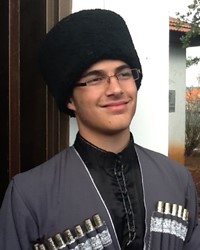The Circassians are the oldest indigenous people of Northwest Caucasus and identify themselves as Adyghe. The Adyghe preserve their culture and continue to use the Adyghe language as their primary means of communication. Only in the 18th century did their language assume a written form. Organized into tribes, the Adyghe have never had an independent state.
Once, the Adyghe were the main ethnic element in northwest Caucasus; however, this drastically changed under the pressure of the Russian conquest, and especially after the defeat of the Great Revolt (1825-1864), when an Adyghe mass exodus took place. This exodus was called 'one of the greatest mass movements of population in modern history'. Adyghe people moved to Turkey and other areas of the Ottoman Empire, including the Middle East. One and a half million Adyghes abandoned their ancient homeland, leaving behind scattered remnant communities. The Russian census of 1897 recorded only 150,000 Adyghe, less than one tenth of the original population. There are many stories, poems and songs about the victims of the war, the emigration itself and the state of exile. Rituals and memorial days are devoted to these events.
Much insight into Adyghe culture and customs can be gathered from their folk dances. The dances tell stories about everyday life such as courtship, preparing for war, the harvest, and showing of strength. All stories ultimately originate from the centuries-old Nart Epics, a series of 26 cycles and 700 texts dating back to 4,000-3,500 BC. The stories preserve Adyghe ancient history, and they are predecessors to Greek mythology, containing ancient stories of gods from southern Russia. From these Epics came the "Adyge habza," or Adyghe traditions.
The habza is an important feature of Adyghe identity and was established long before their Islamization. It is the Adyghe system of laws, rules, etiquette, and ethos. The habza provided the rules of behavior and morality that are handed down in other societies through religion. The Adyge habza is passed on from generation to generation, with today's Adyghe youth still being taught to carry on the traditions.
The Israeli Adyghe, although small and isolated, have succeeded in preserving their culture and identity more than any other Adyghe community in the diaspora. They reside mainly in two villages. They are Sunni Muslims and are recognized as a distinct community. The villages maintain good relations with the nearby Jewish villages and towns, as well as with neighboring Arabs. Adyghe men serve in the army, so structurally their position in Israel is like that of the Israeli Druze. As for the conflict between Jews and Arabs, this is, in Caucasian opinion, a conflict between Semitic cousins and does not relate to them as people of the European side of the Caucasus. A comparison with Jordanian Adyghe is useful, to stress the Israeli community's characteristics.
Many Adyghe were Christianized under Georgian and Byzantine influence in the 6th century. However, under the growing influence of the Ottomans, Islam gradually replaced Christianity and became fully established in the 18th and 19th century, blending with remnants of Christian beliefs and even pre-Christian folk beliefs. It seems that religious influence upon Adyghe collective identity, both in the past and in the present, has been limited and superficial. Some Adyghe became Muslims only during their mass migration, on the ships taking them to the other side of the Black Sea.
The situation of Israel's Adyghe is different, and Islam takes an eminent position in the villages, governing lifestyle and morals. There is also a small percentage of Adyghe who are believed to be Christians.
Today, many Adyghe communities worldwide are facing the problems of losing their language and culture. Yet compared to other migrant groups, the Adyghe have a greater tendency to maintain their separate identity.
Pray for the Holy Spirit to give the Adyghe people in Israel a desire for truth and righteousness that will lead them to the cross.
Pray for changes in Adyghe society to lead them to desire Jesus Christ even more than they crave their own identity and homeland.
Pray for Adyghe disciples who will make more disciples.
Scripture Prayers for the Adyghe in Israel.
| Profile Source: Joshua Project |
| Other PDF Profile |











